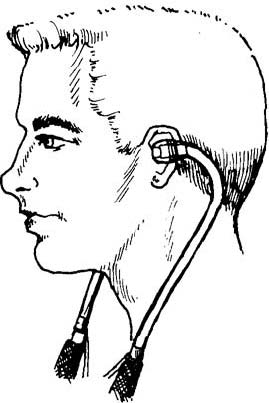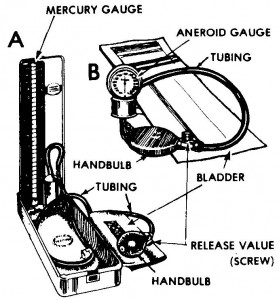You will need a sphygmomanometer (sfig’-mo-mah-NOM-e-ter) and a stethoscope (STETH-ah-skop).
a. Sphygmomanometer.
The sphygmomanometer (figure 5-2) is usually called the “blood pressure cuff.”
There are several different types of blood pressure cuffs in use. Some are made to be attached to a wall (next to a patient’s hospital bed, for example), but most are portable. All blood pressure cuff devices work basically in the same way and have the same parts–a bladder, a handbulb with release valve, a tube connecting the handbulb to the bladder, and a gauge (either mercury or aneroid) for measuring pressure.
Figure 5-2. Sphygmomanometers.A Portable mercury sphygmomanometer.
B Portable aneroid sphygmomanometer.
(1) Bladder. The bladder (also called the “cuff”) is a long rubber bag about 6 inches wide and 24 inches long that is covered with fabric. The bladder is wrapped around the patient’s arm and filled with air when taking the patient’s blood pressure.
Parts of the fabric are made of non-slip material, such as Velcro. When the fabric is overlapped, the two pieces of fabric adhere to each other and will not slip when the bladder is inflated. Some sphygmomanometers use snaps or other devices to secure the bladder instead of non-slip fabric.
(2) Handbulb. The handbulb is a device for inflating the bladder. When squeezed, the handbulb forces the air through an opening connected to the tubing. When the bulb is released, it refills with air from the environment. The handbulb is designed so that air from the tubing cannot flow back into the handbulb.
(3) Rubber tubes. One tube connects the bladder and handbulb. Air that is forced out of the handbulb travels through the tube and enters the bladder. A second tube connects the bladder and the gauge.
(4) Release valve. The release valve (screw) is a device for releasing air from the bladder. It is located between the handbulb and the tubing. One hand can operate both the handbulb and the release valve easily. The valve is controlled by a screw. When tightened, no air escapes. When unscrewed fully, the air escapes rapidly. (Note: The screw does not separate from the apparatus. “Unscrewed fully” means the screw is turned so that air will escape as fast as possible.)
The screw can also be turned to any position between completely closed and full release. In this way, you can let air escape from the bladder as quickly or as slowly as you wish.
(5) Gauge. The gauge measures the air pressure in the bladder. There are two types of gauges–the mercury gauge and the aneroid gauge.
(a) Mercury. The mercury gauge has a column of mercury in a glass tube. The column of mercury measures the air pressure in the bladder. The higher the pressure of air in the bladder, the higher the column of mercury. The height of the column of mercury is determined using a scale to the side of the tube containing the mercury.
Usually there is a scale on each side of the glass tube in order to make it easier to read the height of the column. As air is released from the bladder, the air pressure drops and the column of mercury becomes shorter.
(b) Aneroid. The aneroid gauge is circular and has a dial. The greater the air pressure in the bladder, the farther the needle on the dial rotates. A scale on the dial is equivalent to the scale of the mercury gauge. Both scales measure the force of air pressure in the bladder in terms of mm Hg. As the air pressure is released, the needle moves in a counter-clockwise direction.
The gauge will normally be designed so that it can be attached to the bladder. This frees the person taking the blood pressure from having to hold the gauge in one of his hands.
b. Stethoscope.
The stethoscope is an instrument used for listening to sounds produced within the body. A stethoscope consists of a diaphragm, metal and rubber tubing, and earpieces (figure 5-3).
(1) Diaphragm. The diaphragm is normally a flat metal disk that is placed on the body area being examined. The diaphragm will pick up sounds produced within the body such as the heartbeat and breathing sounds. Sometimes a bell-shaped listening device is used instead of a flat disk. Some stethoscopes have combination (both flat disk and bell) listening devices.
(2) Tubing. The hollow and metal tubes transmit the sounds from the diaphragm to the earpieces. The rubber tubing provides flexibility.

(3) Earpieces. The earpieces are twisted metal tubes with plastic ends. The plastic pieces protect the ears from the metal. The twisting helps to improve the quality of sound heard through the stethoscope. The stethoscope should be worn with the earpieces forward (figure 5-4) to help prevent the sounds picked up by the diaphragm from being distorted.


